A Passive Islanding Method to Improve the Stability of Power Supply to Critical Loads in a Real Distribution Network
Abstract
This study proposed a modified passive islanding technique that combines over/under frequency (OUF), rate of change of frequency (ROCOF), rate of change of phase angle difference (ROCPAD), and rate of change of voltage (ROCOV) for sensing of islanding and nonislanding conditions. The technique was implemented in MATLAB/Simulink and applied to the distribution network of the Federal Capital Territory (FCT) of Nigeria containing 120 buses to maintain a stable power supply to its critical loads during grid outages. The method utilized the frequency, voltage, and current signals as input to the combined method. For each of the relays, the low threshold was for a fast operation while the high threshold was for a secure operation. First, the OUF, ROCOF, ROCOV, and ROCPAD relays were combined using an AND gate to limit the relay operation during short circuits since the ROCOV measures the voltage drop and determines whether it is in grid-connected or islanding mode. After that, the higher set threshold of the ROCOF was connected using a logical OR gate to limit the operation of the relay under transients and noises. Finally, the higher set threshold of the ROCPAD was used to sense islanding in case the lower threshold failed to initially detect it. The efficacy of the technique was tested on the FCT distribution network, and the result showed successful islanding for the loss of the grid supply and loss of power supply due to fault on the 330 kV line, while the loss of 33 kV feeder and loss of power supply at a single supply point were nonislanding events. After islanding due to an outage and loss of the 330 kV line, it took 0.01138 and 0.000316 s to switch to the DES, and the optimal capacities that supplied power to the critical loads were 33.2 MW at Bus 13, 18.9 MW at Bus 120, 48.4 MW at Bus 72, and 45.1 MW at Bus 46. The total connection of the DES was able to supply 144.8 MW out of the total peak load of 600 MW which represents about 24.13% of the total system load referred to as the critical loads. Therefore, connecting DES capable of islanding operation to the distribution network improves power supply security, supply continuity to consumers, and customer satisfaction.
1. Introduction
The study focuses on the application of the islanding technique to the distribution network of the Federal Capital Territory (FCT) of Nigeria to ensure continuity of power supply to the critical loads connected to the network. The FCT is an important load center given the importance of the city as the administrative capital of the country and one of the fastest-growing cities in Nigeria, it is important to maintain supply to the critical loads. The critical loads include the seat of power, the national assembly, security agencies, educational institutions, health institutions, and commercial and industrial clusters amongst others. However, during periods of outages, the critical loads are not isolated, and their supply is interrupted. Therefore, it is important to maintain the supply to the distribution network to meet the load demand of the important loads.
The distribution network is a crucial component of the power system supply chain because it provides power to the customers. Improvements in how this power can be delivered to different customers have been explored in recent years. One of the most significant achievements in improving power supply to customers is the connection of distributed generation (DG) close to their load. The increasing use of DG is providing customers and utilities opportunities to improve power supply, increase reliability, improve power quality, and others [1]. However, during gridwide outages, the supply to connected loads is lost. To ensure continuity of supply to these loads during outages, it is important to create an islanding scheme within the distribution network. Islanding happens when the DG supplies power to the distribution network even if dissociated from the grid [2]. Islanding is accomplished by using remote techniques and local approaches.
Remote detection techniques utilize signals between the DG and the utility for island detection. Although remote methods perform better compared to local ones, they are more expensive and complicated to execute, and if there is a signal problem, the network can fail. Some remote techniques include phasor measurement units, transfer trips, power line carriers, supervisory control, and data acquisition [3]. The local islanding detection methods use voltage, frequency, real power, reactive power, phase angle, impedance, and other signals for the islanding process [4]. Local islanding detection methods are divided into passive, active, and hybrid methods [5, 6]. Passive methods are generally employed because of their ease of implementation, affordable cost, zero effect on power quality, and fast detection speed. However, these methods are characterized by the nondetection zone (NDZ) present in them [4, 7]. The passive techniques include over/under frequency (OUF), over/under voltage, rate of change of frequency (ROCOF), rate of change of voltage (ROCOV), rate of change of phase angle difference (ROCPAD), harmonics detection, and others [4, 8]. The active islanding methods operate by introducing disturbances into the system and comparing the outcome to a preset value. An island situation is deemed to occur if the outcome is larger than the threshold [9]. In active methods, the NDZ is significantly reduced; however, the disturbance created during island detection degrades the quality of power. Some types of active techniques are active frequency drift, slide-mode frequency shift, reactive power variation, Gibbs phenomenon–based frequency shift, and many others [10]. The qualities of the active and passive methods are used to create hybrid methods to detect islanding [11]. In this method, the passive IDM suspects the islanding, while the active IDM confirms the islanding. Although the hybrid methods are complex to implement, they offer NDZs and a lesser effect on power quality. Some hybrid methods include positive feedback and voltage unbalance, voltage and active power shift, Sandia frequency shift and ROCOF, and others [3].
In IEEE 1547, it is expected that the time to establish an island will be less than 2 s and the detection should be made very quickly using the appropriate techniques for the secure operation of the islanded network [10, 12]. To meet the criteria mentioned above, there has been much interest in the development of hybrid, active, and passive IDMs. The drawback of hybrid methods is that they are complex and expensive to implement, while active techniques can lead to power quality degradation because of the injected disturbances. Therefore, the passive methods, even though may suffer from NDZs, are simple, easy, and less expensive to implement. In recent times, several works have been performed with a focus on utilizing passive islanding detection methods, and by appropriately combining them, the NDZ is significantly reduced.
In this work, the MATLAB/Simulink program was used to implement the passive islanding method. The OUF, ROCOF, ROCOV, and ROCPAD were logically combined to island the distribution network of the FCT and maintain supply to critical loads. The islanding condition considered the loss of power supply to the FCT distribution network and the major fault on the 330 kV line linking the two supply points to the distribution network which resulted in power mismatches. During the high-power mismatch, a significant change in the frequency and voltage resulted in islanding, while for the low-power mismatch, the logical combination of the relays was also able to detect islanding. For the nonislanding situations, the loss of the 33 kV feeder and loss of generation at a single point at either of the 330 kV buses were considered. The logical combination of the relays resulted in the nondetection of islanding for the loss of the 33 kV feeder and the loss of power on either of the 330 kV buses that supply power to the distribution network.
The remaining sections have the following organization. The review of literature is covered in Section 2, while the passive islanding technique used is given in Section 3. The result is presented in Section 4 and Section 5 gives the conclusion.
2. Review of the Literature
A novel passive islanding approach with an adaptive threshold was proposed to address the microgrid islanding problem [10]. The rate of change of the power factor angle was used to identify islanding and nonislanding events. The method demonstrated high reliability; however, the study can be improved by considering stability during system disturbance and reduction of the NDZ. Similarly, in [13], a passive islanding technique uses ROCPAD to sense islanding. Although the method detected islanding rapidly with minimal NDZ, it did not consider the application of the method to multiple DGs in an islanded network. In the same development, a passive islanding technique in [14] used the ROCPAD to detect islanding. The proposed method was compared with the ROCOF and tested for various fault conditions and transient cases. The results showed that the proposed technique worked effectively with low NDZs. However, the study can be extended to island multiple DGs in a real distribution network. Also, the authors in [15] focused on the islanding of a hydrogenerator connected to a medium-voltage feeder. The presented findings highlighted important stages that cover island detection and restoration. However, the research did not consider a large network with multiple DGs. Furthermore, the rate of change of power based on the terminal voltage of the photovoltaic (PV) was studied using MATLAB/Simulink [16]. The techniques’ results revealed that the proposed technique was adequate to detect islanding under most conditions except when there was a low power mismatch. In another study, passive islanding detection was carried out for multiple DGs using a backward and forward sweep method coupled with network reconfiguration [11]. Islanding was identified by measuring values of the frequency and the voltage with predetermined limits. However, the study did not consider the interruption cost for the energy not supplied. Similarly, the authors in [17] presented a passive islanding approach based on the measurement of voltage and current at the connection point and using a resultant sequential impedance component. The method was successful in distinguishing between islanding and nonislanding events. The work can be extended to consider real-time scenarios and real systems. The modified passive islanding detection method in [18] used a voltage–frequency index to the island to reduce NDZs. The proposed method showed a reduction in the detection time as well as the islanded buses. The work suggested implementation of corrective measures to reduce power imbalances which is a concern for passive detection methods.
A novel perturbation current signal was presented in [19] on the sensing of islanding in a three-phase PV system. When islanding occurred, the injected signal caused a variation in the terminal voltage. The islanding method was tested for several load scenarios and the results revealed that the method was faster than other active islanding techniques. However, the proposed method was found to have a bigger NDZ than the other active methods and was complex to realize. In addition, a hybrid islanding detection method was suggested using the ROCOV and the rate of change of active power. The islanding was only detected when the ROCOV relay operated; this means that for parameters other than voltage change, islanding was not detected [20]. In a related development, a hybrid technique for grid-connected PV systems (GCPVSs) was proposed [21]. An actual distribution system with three GCPVSs was used, and the results showed effective islanding detection with a small NDZ within 300 ms and with correct operation during nonislanding conditions. However, a degradation of the quality of its output power was observed.
In [22], a passive islanding detection technique was proposed for a grid-connected hybrid distributed generating system using second-generation wavelet transform and maximum overlap discrete wavelet transform. The proposed methods detected islanding by considering the lower-frequency components of the voltage signal. Therefore, this method may be limited for islanding due to other parameters. The authors of the work in [23] proposed a new approach to islanding detection that can be performed on power distribution buses at lower voltages intended to safeguard DG-fueled systems. The work shows that additional findings are required to reduce NDZs and address issues associated with false tripping because of unexpected changes in the load during islanding detection. Also, the authors in [24] presented an approach to power management and island detection of multiple microgrids tied to the grid using ANFIS. The results of the work showed that the proposed method was able to distinguish between islanding and those that were not. However, the study was based on voltage variation, and it did not consider the ROCOF, real-time implementation, and application of optimization techniques to enhance its operation. A voltage-based cooperative injection impedance angle measurement anti-islanding protection was proposed in [25] The method resolved the failure problem of existing anti-islanding protection based on impedance measurement caused by the signal interference between DGs. The proposed method suggests the application of the method to a practical system.
Different methods of islanding detection described have some drawbacks that can lead to maloperation. The operation of OUF relays depends on the frequency. If there is a low mismatch on the islanded network, the frequency will have little variations that may not exceed the limits leading to false detection. For ROCOF, when the value exceeds the preset setting, a trip signal is activated. Like OUF, when the power disparity is small, the frequency varies slightly, and the ROCOF may not operate correctly. In addition, transient events in the system can result in variations in frequency, causing wrong operation. In the ROCOV, the reactive power imbalance is used to identify islanding. In a typical network situation, a load loss having a small power factor gives a high reactive power imbalance, and this may cause the ROCOV to operate incorrectly. Also, when there is a small variation, the ROCOV may not sense the values and thus cannot detect islanding. Furthermore, the ROCPAD method can be used to detect islanding in the low power mismatch, which is a drawback of the OUF and ROCOF. Although the method can detect islanding with 0% power mismatch, it can malfunction during a short circuit fault [26]. Hence, the combination of these methods is important to achieve the islanding of critical loads within the FCT distribution network.
- •
This work has shown that the passive islanding method is easy to realize, effective, fast, and can be applied to networks with single or multiple DGs without reducing the power quality.
- •
The outcome of this study revealed that the method is characterized by a minimal NDZ and fast DG switching time.
- •
The study also showed that following the implementation of the islanding method, the critical loads within the FCT distribution system were supplied by the connected DGs during systemwide outages. In addition, the method considered restoration of the supply to the load in the system after the islanding.
- •
An important part of the work from an economic perspective is that the DGs were only activated to supply critical loads when the grid outage occurred. Immediately, the grid power was restored, the DGs were deactivated, and the grid supplied all the loads in the network. In this way, the cost of the power is affordable as only critical loads are supplied during outages.
3. Implementation of the Proposed Passive Islanding Scheme
This research work utilizes a combined islanding scheme comprising OUF, ROCOF, ROCOV, and ROCPAD. The amalgamation of these methods into the proposed technique leads to a more robust and secure operational solution.
3.1. OUF
3.2. ROCOF
3.3. ROCOV
3.4. ROCPAD
3.5. Amalgamation of Methods
This work combined OUF, ROCOF, ROCOV, and ROCPAD by using frequency, voltage, and current signals to effectively island or maintain continuity of supply to the network. The work adopted the methodology in [26] but modified it by adding the restoration back to grid supply and its application to a real distribution network of the FCT. By this, islanding was detected, and the supply to important loads in the FCT distribution network was maintained. The suggested method was implemented in MATLAB/Simulink and the methodology is shown in Figure 1.
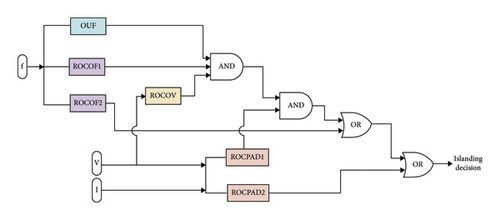
In the proposed islanding technique in Figure 1, the thresholds for ROCOF1 and ROCPAD1 are lower making them act faster than the higher set thresholds for ROCOF2 and ROCPAD2, which guarantees secure operation. As mentioned earlier, the ROCOF, ROCPAD, and OUF relays may not operate correctly for short circuits. During short circuits in grid-connected mode, the voltage drops rapidly to a new value after a short period, while it drops slowly in islanding mode. With this, the ROCOV relay can separate the short circuit faults from the islanding mode. Therefore, the output of the ROCOV, ROCOF1, and OUF relays are connected by the first AND gate to limit their operation in short-circuit faults. In the next stage, the first AND gate is combined with ROCPAD1 using the second AND gate for island detection. If the ROCPAD1 is limited in operation, then ROCPAD2 will act because it has a higher threshold; hence, it does not recognize short circuit faults as islanding mode. In addition, since noise and transient faults change the frequency quickly, the ROCOF1 value may exceed its threshold, while the frequency does not change significantly. Therefore, the ROCOF2 relay with a higher threshold operates in parallel with ROCPAD2 for a secure operation.
3.6. The FCT Distribution Network
The network of the FCT distribution system in [29] was expanded to 120 buses to achieve the objective of this study. The distribution network of the FCT is supplied from the grid via the 330/132/33 kV substations at Katampe and Gwagwalada. However, due to grid limitations, only about 50% of the peak load is supplied. Therefore, the study considered the islanding of the distribution network and the continued supply of the critical loads within the network using four DGs, until the main grid supply is restored. The modeling, simulation, and programming were achieved with the MATLAB/Simulink 2022b software. The proposed islanding scheme was applied to the FCT distribution network shown in Figure 2.

In Figure 2, the DGs were connected to the 33 kV buses at Katampe (DG1), Central Area (DG2), Apo (DG3), and Karu (DG4) based on the network needs following the power flow analysis. The proper connection of the DGs was based on the methodology of the study carried out in [30]. The DGs were activated only to supply critical loads within the FCT distribution network when islanding occurred. The DG capacities of the four connected generators are shown in Table 1.
| DG name | Connection point (kV) | Generation (MW) |
|---|---|---|
| DG1 | Katampe 33 | 33.2 |
| DG2 | Central area 33 | 45.1 |
| DG3 | Apo 33 | 48.4 |
| DG4 | Karu 33 | 18.9 |
| Total | 145.6 | |
As seen in Table 1, a total generation of 145.6 MW from DG 1 to DG 4 was connected to the respective 33 kV buses in the FCT network. The peak load of the distribution network is about 600 MW. After the islanding of the network, the total DG capacity of 145.6 MW was used to supply only the critical load of 144.8 MW, which is about 24.13% of the total 600 MW peak load. The identified critical loads used for this study are summarized in Table 2.
| S/N | Substation 132/33 kV | 33 kV feeder name | Connected customers | Load (MW) |
|---|---|---|---|---|
| 1 | Gwagwalada | L32 | University of Abuja | 5 |
| L36 | Gwagwalada Injection substation | 10 | ||
| 2 | Kukwaba | L31 | African University of Science and Technology | 0.3 |
| L36 | Nile University, Idu Industrial Area, and Life Camp | 6.5 | ||
| L35 | Railway, Economic and Financial Crimes Commission | 1 | ||
| 3 | Apo | H5 | Aso Villa, Powerhouse, Eyadema, Guzape I, and Guzape II | 18 |
| H3 | Three Arms Zone and Central Business Area | 12 | ||
| H23 | International airport | 2 | ||
| H1 | Some embassies | 3 | ||
| National Hospital | 6 | |||
| H21 | Nigeria Immigration Service, Nigerian Air Force, Domestic airport, Voice of Nigeria, Space Center, etc. | 2 | ||
| 4 | Katampe | Wuse II | Wuse II commercial area | 18 |
| Maitama C3 | Supplies a lot of government and private establishments | 18 | ||
| 5 | Kubwa | Usman Dam | Dam for major water supply in the FCT area | 1 |
| Gwarinpa | One of the biggest estates in Nigeria with a lot of commercial centers | 10 | ||
| 6 | Central area | Feeder 6 | Maitama C2 has a lot of important office establishments | 10 |
| Feeder 2 | Central area offices such as the Powerhouse, Transcorp Hilton, and other important government institutions | 5 | ||
| Feeder 3 | Other Ministries, departments, agencies, embassies, etc. | 12 | ||
| 7 | Karu | K3 | City College | 5 |
| Total | 144.8 | |||
As observed from Table 2, the critical loads are in the 132/33 kV substations, and they include important government agencies, schools, hospitals, and commercial centers amongst others. These critical loads require adequate and constant power to carry out their operations. Therefore, the DGs were connected to supply the loads during a total grid outage. After the grid restoration, the DGs were deactivated, and the main grid resumed power supply to the loads. The modeling, simulation, and programming were achieved using the MATLAB/Simulink 2022b software.
3.7. The Islanding and Nonislanding Conditions
The study considered different islanding and nonislanding conditions as follows:
- •
Loss of power from the grid corresponding to grid collapse, i.e., at both Gwagwalada and Katampe 330 kV buses
- •
Three-phase fault on the 330 kV line connecting the Gwagwalada and Katampe 330/132 kV substations
- •
Loss of 33 kV feeders
- •
Power supply loss on the Gwagwalada 330 kV bus
- •
Loss of power supply at Katampe 330 kV bus
- a.
The islanding condition considered the loss of power supply to the FCT distribution network. During the islanding with a high-power mismatch, there is a significant change in the frequency and voltage. This causes the OUF, ROCOF1, and ROCOV to sense the islanding and operate by activating the first logical AND gate to give an output of one. Likewise, the ROCPAD1 also operates due to significant changes in the voltage and current phase angle difference, and when combined with the second AND gate, also gives an output of one. From here, the output of the second AND gate and the combination of the OR gate for ROCOF2 and ROCPAD2 leads to the detection of islanding.
- b.
During the islanding with low power mismatch such as the loss of power on the Gwagwalada–Katampe, the OUF, ROCOF1, and ROCOV may not sense islanding making their output zero. ROCPAD1 gives the output of one due to an increase in the voltage and current phase angle difference. However, when the output of ROCPAD1 is combined with the zero obtained from the first AND gate, the output of the second AND gate becomes zero. In this case, islanding is detected by the ROCPAD2, which is effective even for near-zero mismatch.
- c.
The nonislanding considered in this work is the loss of the 33 kV feeder and loss of generation at a single point at either of the 330 kV buses. For the loss of the 33 kV feeder, the power mismatch is low, and the short circuit is not significant, hence the ROCOV blocks the operation thereby making the first AND gate zero. The high threshold setting of ROCOF2 and ROCPAD2 makes them not to operate during short circuits, thereby returning a final value of zero for the combination. In this instance, islanding is not detected.
3.8. Steps for Implementing the Methodology in MATLAB/Simulink
- i.
The program and network modeling for the islanding and restoration were developed in MATLAB/Simulink
- ii.
The MATLAB program for each of the islanding and nonislanding was used to run the Simulink Model
- a.
For normal operation, the network was run with all the loads in service supplied from only the grid. In this scenario, the DGs were deactivated.
- b.
When islanding was detected, the power supply from the grid was cutoff, and the DGs were activated to supply only the critical loads while the noncritical loads were switched off.
- a.
- iii.
For the restoration, the DGs were deactivated, while the grid supply was reinstated to supply the total load in the distribution network.
The modeled islanding methods in MATLAB/Simulink are shown in Figure 3.
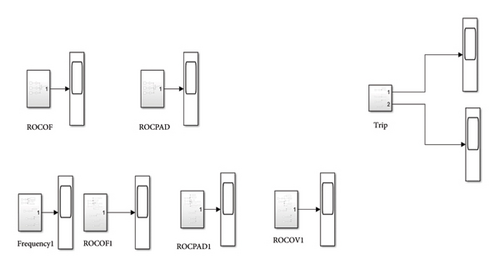
In Figure 3, the OUF, ROCOF, ROCOV, and ROCPAD are modeled and combined using the logic gate to sense islanding and nonislanding conditions.
4. Results and Discussion
Following the implementation of the islanding scheme in MATLAB/Simulink, the results of the islanding and nonislanding scenarios were considered for the different events analyzed in this section.
4.1. Loss of Power From the Grid
This scenario considered the loss of supply from the grid at both Katampe and Gwagwalada 330 kV buses. This power loss on the grid caused islanding and dissociation of the FCT distribution network from the grid due to the high-power mismatch. During this period, the DGs were activated and the critical loads in the distribution system were supplied, while the noncritical loads were deactivated. The result of the islanding scenario for the loss of grid supply is shown in Figure 4.
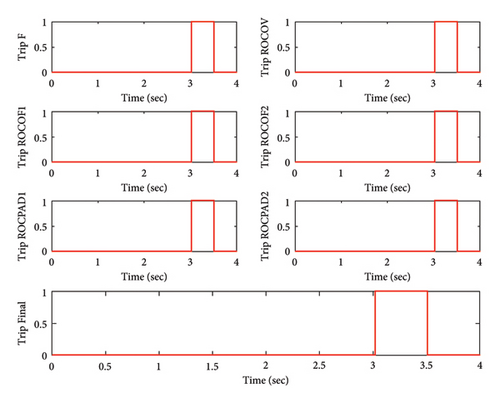
Following the combined operation of the methods, the trip signal was activated, and this led to the islanding condition as shown in Figure 4. The islanding condition was caused by a large power mismatch which activated the OUF, ROCOF1, and ROCOV through the combination of the first logical AND gate. Since the situation was a true islanding one, ROCPAD1 combined with the output of the first logic AND gate to activate the second AND gate. The output of the second AND gate combined with the ROCOF2 and the ROCPAD2 to give a final islanding decision. The time of 0.01138 s was recorded as the switching time for the activation of the DG to occur following the islanding.
4.2. Three-phase Fault on the 330 kV Line
For this scenario, a three-phase fault was simulated on the Gwagwalada–Katampe 330 kV line. The results show that the islanding occurred in the network at t = 3 s. This islanding condition was a result of a major fault on the 330 kV line, the major supply point to the FTC distribution network. This led to a large power mismatch, which is similar to the loss of the main grid supply. The islanding condition following the major fault on the Gwagwalada–Katampe 330 kV line is shown in Figure 5.
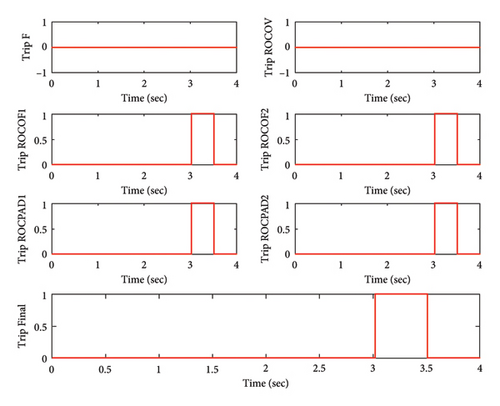
Following the combined operation of the methods, the trip signal for the OUF and the ROCOV was not activated, while the trip signal for the ROCOF and the ROCPAD was active, leading to islanding, as can be seen in the final trip signal in Figure 5. It can be seen that even for low power mismatch, the method was able to island the network. Under this scenario, the DG switching time of 0.000316 s was recorded.
4.3. Loss of 33 kV Feeder
Under this scenario, a fault was applied to a 33 kV feeder to test the effectiveness of the developed methods. The result for the trip signals is shown in Figure 6.
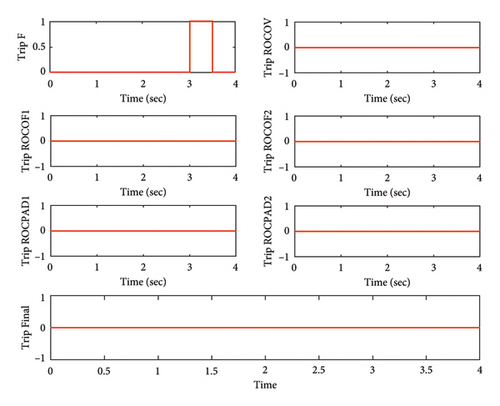
Following the combined operation of the methods as shown in Figure 6, the final trip signal was not activated, resulting in a nonislanding condition. Only the OUF trip signal was activated since the method is not effective for low power mismatch, as is the case for this scenario. Therefore, the final trip signal showed that islanding did not occur due to the loss of a 33 kV feeder. The loss of load in comparison to the total load of the system is negligible to cause an imbalance in the distribution network to trigger the islanding.
4.4. Loss of Power Supply at Gwagwalada 330 kV Bus
The islanding method was also tested for power loss on the Gwagwalada 330 kV bus. The result of OUF, ROCOF, ROCPAD, and ROCOV is shown in Figure 7.
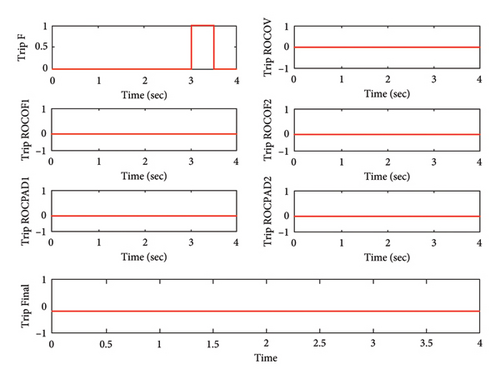
The combined operation of the islanding methods in Figure 7 shows that the islanding was not activated due to power loss on the Gwagwalada 330 kV bus. Although the OUF was activated due to the sudden response in frequency over a short period as a result of the loss of generation from one side of the supply, the final trip signal was not activated resulting in a nonislanding condition. This is possible because with the power loss in Gwagwalada, the generation from the Katampe 330 kV bus was adequate to supply the load of the FCT distribution network, thus preventing the island condition.
4.5. Power Supply on the Katampe 330 kV Bus
The study also considered the application of islanding methods for power loss on the Katampe 330 kV bus which is similar to the previous section. The result of OUF, ROCOF, ROCPAD, and ROCOV is shown in Figure 8.

The combined operation of the islanding methods in Figure 8 shows that islanding did not occur when there was a power loss on the Katampe 330 kV bus. This is because the final trip signal was not activated resulting in a nonislanding condition. This is possible because, with the loss of power supply in Katampe, the load in the FCT network was supplied from the Gwagwalada axis.
5. Conclusions
This study considered a passive islanding method based on the combined logical operation of OUF, ROCOF, ROCOV, and ROCPAD to the island and to maintain supply to critical loads in the FCT distribution system. The method utilized the frequency, voltage, and current signals as input to the combined method. The work was executed in MATLAB/Simulink and applied to the 120-bus FCT distribution system under some islanding and no-islanding situations. The result showed the successful islanding of the distribution network for the loss of grid supply and three-phase fault on the 330 kV line connecting the Gwagwalada and Katampe substations, while there was no islanding for the loss of the 33 kV feeder and loss of supply at either Gwagwalada or Katampe 330 kV buses. After islanding due to an outage and loss of the 330 kV line, it took 0.01138 and 0.000316 s, respectively, to switch to the DES operation. The outcome of this study revealed a minimal NDZ and fast DG switching time. In addition, from an economic point of view, the DGs were only activated to supply critical loads when the grid outage occurred. Immediately after the grid power was restored, the DGs were deactivated, ensuring all the loads were connected. Future studies should consider the application of artificial intelligence methods to sense islanding in a large network to eliminate human error and increase the robustness of the scheme. Also, the effect of large-scale renewable energy systems on the islanded network can be further studied.
Conflicts of Interest
The authors declare no conflicts of interest.
Funding
This research did not receive external funding.
Acknowledgments
The authors sincerely appreciate the Nile University of Nigeria, Abuja, for their support. Furthermore, we extend our thanks to the Abuja Electricity Distribution Company for providing the data.
Open Research
Data Availability Statement
The data used are included within the manuscript.




